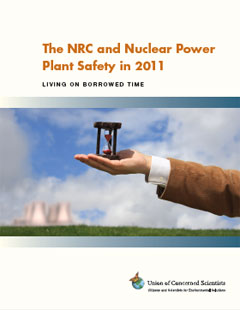The Nuclear Regulatory Commission, the federal agency responsible for ensuring that U.S. nuclear plants are operated as safely as possible, gets mixed reviews again in our second annual assessment of NRC response to safety problems, The NRC and Nuclear Power Plant Safety in 2011: Living on Borrowed Time.
The report examines 15 “near-misses” at U.S. nuclear plants during 2011 (see table below) and evaluates the NRC response in each case. Since NRC inspections cannot reveal more than a fraction of the problems that exist, it is crucial for the agency to respond effectively to the problems it does find.
In addition to these 15 near-misses, the report offers examples of both positive and negative outcomes from NRC inspections:
Positive
Fort Calhoun. NRC inspectors' insistence that the plant comply with flood protection requirements came in handy when a Missouri River flood inundated the plant site in June.
Hatch. A 1995 decision had allowed plant operators to substitute warning indicators for an automated shutoff system designed to protect pump motors from voltage dips. In 2011, the NRC recognized this as a mistake and rectified it.
LaSalle. Inspectors noticed that a tank was left partly filled with water between system tests—a condition that put the tank at risk of collapse during an earthquake, possibly damaging pumps and other equipment. The problem was fixed not only at LaSalle but at another plant whose owner read about the issue and realized his plant shared it.
Negative
CDBIs. Each plant periodically undergoes component design basis inspections (CDBIs) to ensure that plant systems and procedures conform to design requirements. A lack of improvement in CDBI results over time indicates a failure to address root causes; the NRC is treating the symptoms, but not the disease.
Fire Protection. The NRC's insistence that 47 reactors are safe enough to continue operating despite their continued failure to comply with fire protection regulations does not stand up to legal or ethical scrutiny.
Earthquake Risk. Similarly, the NRC continues to allow 27 plants to operate with seismic protection levels inadequate to meet seismic threat levels, even though it has been aware of the problem for over a decade. Making matters worse, eight plants have inadequate protection from both fire and earthquake.
Lessons learned
The risk of a disaster at a nuclear power plant is low—and last year brought a series of reminders, both in Japan and the United States, of how important it is to keep that risk as low as possible. The NRC can be a highly effective regulator, but much remains to be done before the agency can fulfill that role as consistently as the public has a right to expect.




